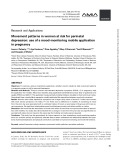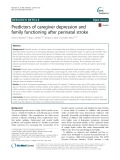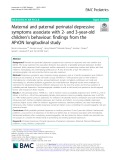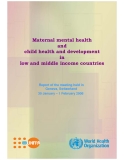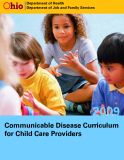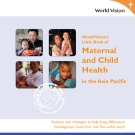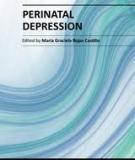
Perinatal depression
-
To examine, using a smartphone application, whether mood is related to daily movement patterns in pregnant women at risk for perinatal depression. This study lays the groundwork for future research on how smartphone mood-monitoring applications can combine actively and passively collected data to better understand the relationship between the symptoms of perinatal depression and physical activity that could lead to improved monitoring and novel interventions.
 8p
8p  visteverogers
visteverogers
 24-06-2023
24-06-2023
 5
5
 2
2
 Download
Download
-
Bereaved parents experience higher rates of depressive and post-traumatic stress symptoms after the stillbirth of a baby than after live-birth. Yet, these effects remain underreported in the literature and, consequently, insufficiently addressed in health provider education and practice.
 8p
8p  vigeorgia2711
vigeorgia2711
 30-11-2020
30-11-2020
 14
14
 2
2
 Download
Download
-
Perinatal stroke is a leading cause of cerebral palsy and lifelong neurological morbidity. Studies on perinatal stroke outcomes are increasing, although examinations of its broader impact on parents and families have been limited.
 11p
11p  vichengshin2711
vichengshin2711
 26-02-2020
26-02-2020
 12
12
 1
1
 Download
Download
-
Prenatal and postnatal depressive symptoms are common in expectant and new mothers and fathers. This study examined the association between four patterns of probable perinatal depression (mother depressed, father depressed, both depressed, neither depressed) in co-parenting mothers and fathers and their children’s internalizing and externalizing behaviours at 24 and 36 months of age.
 13p
13p  vidublin2711
vidublin2711
 13-01-2020
13-01-2020
 15
15
 1
1
 Download
Download
-
Gaynes et al. (109) did a meta-analysis of screening instruments (i.e., EPDS, Beck Depression Inventory (BDI), Postpartum Depression Screening Scale (PDSS), and the Center for Epidemiological Studies Depression Scale (CES-D)) for depression and concluded that, "various screening instruments can identify perinatal depression". They concluded that these instruments have high specificity and low sensitivity for depressive states, and this acquires a greater importance when deciding on whether false-positives or false-negatives are preferred.
 39p
39p  can_thai
can_thai
 12-12-2012
12-12-2012
 47
47
 3
3
 Download
Download
-
The impact of perinatal mental health problems on infants has been studied in HIC, mostly in terms of neuro-psycho-behavioural variables, which are likely to apply in LMICs as well. Infants of depressed mothers show dysregulations affecting their behavior and physiology, thought to be derived from a prenatal exposure to a biochemical imbalance in their mothers (48, 70). Newborns of depressed mothers also have neurotransmitter imbalances (e.g., higher cortisol and lower dopamine and serotonin levels), are described as physiologically less mature (e.g.
 37p
37p  can_thai
can_thai
 12-12-2012
12-12-2012
 43
43
 4
4
 Download
Download
-
Various hypotheses have been advanced to explain the high prevalence of mental health problems during the perinatal period, ranging from biological (e.g., hormones and neurochemical modifications) to psychological (e.g., personality types and ways of thinking) and social determinants (e.g., gender disparities in access to education and income-generating opportunities, social roles, disproportionate burden of unpaid work, exposure to family violence, low autonomy, poverty and coincidental adversity) explanations.
 0p
0p  can_thai
can_thai
 12-12-2012
12-12-2012
 55
55
 2
2
 Download
Download
-
Studies conducted in HICs indicate a prevalence of 10-15% of perinatal mental disorders (11, 12). It has been suggested that rates of first onset and severe depression are three times higher in the postnatal period than in other periods of women's lives (13). More recently, Gavin et al. (14) confirmed those findings, suggesting that the rates are particularly high during the first trimester following childbirth.
 48p
48p  can_thai
can_thai
 12-12-2012
12-12-2012
 48
48
 1
1
 Download
Download
-
We are delighted to present Integrative Women’s Health—the fi rst such text created for health professionals. It is our hope that you will fi nd it of great value as you care for your patients. As the largest group of health care consumers, women have made it abundantly clear that they desire a broader, more integrative approach to their care. In response to this need, we have elected to cover both women’s reproductive health and those conditions that manifest diff erently in wome
 713p
713p  kimngan_1
kimngan_1
 09-11-2012
09-11-2012
 130
130
 14
14
 Download
Download
-
In the Western world, the arrival in the 20th century of the Welfare State meant that the basic needs of citizens in terms of health, hygiene and socio-economic considerations were met to a greater extent than ever before. It soon however became apparent that, as Maslow’s hierarchy of need predicts (Maslow, 1943), people continued to want more, they needed choices, and they sought opportunities to fulfil ambitions and goals.
 200p
200p  ti_du_hoang
ti_du_hoang
 02-08-2012
02-08-2012
 49
49
 3
3
 Download
Download
-
Since the recognition of the importance of antenatal as well as postnatal depression, a number of studies have looked at the prevalence of depression among pregnant women in the developed and developing world. Prevalence rates vary because of a variety of methodological factors.
 54p
54p  pt_1669
pt_1669
 26-03-2012
26-03-2012
 211
211
 70
70
 Download
Download
-
The line between depressive and anxiety disorders in perinatal as well as general populations is often blurred; when the EPDS has been factor-analyzed, although there are separate factors corresponding to depression and anxiety, several items have moderate loadings on both factors (Swalm, et al., 2010). Some services refer to antenatal or postnatal “distress” rather than attempt to differentiate depression from anxiety, and often women report a mix of anxious and depressed symptoms.
 63p
63p  pt_1669
pt_1669
 26-03-2012
26-03-2012
 164
164
 65
65
 Download
Download
CHỦ ĐỀ BẠN MUỐN TÌM








